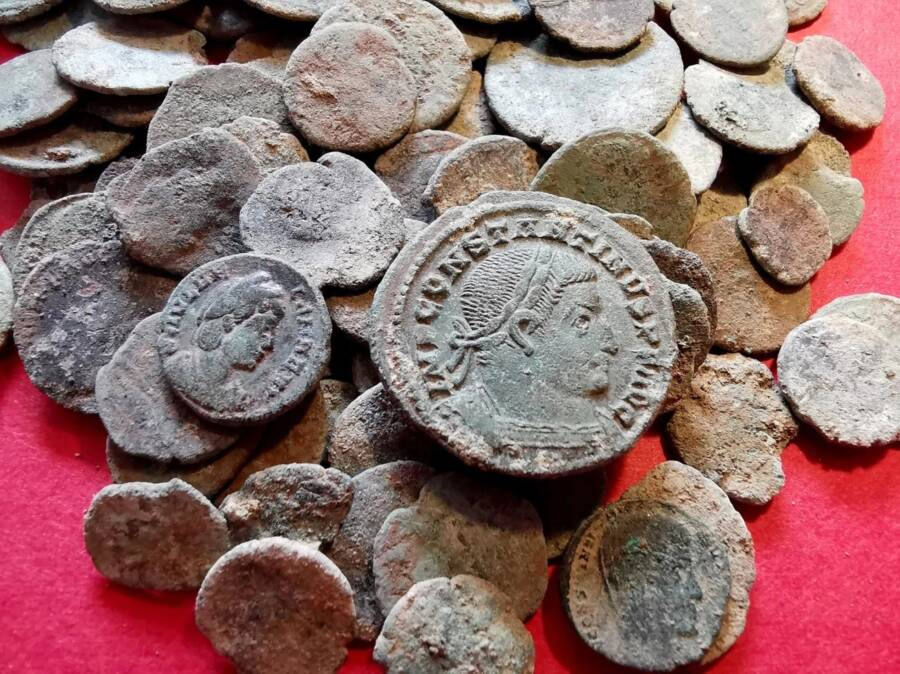The 209 coins date back to between the third and fifth centuries and were minted across the Roman empire.

MINISTRY OF CULTURE OF THE PRINCIPALITY OF ASTURIASArcheologists found hundreds of coins and believe the cave may contain even more.
Usually, it’s a skilled archeologist who unearths history’s treasures. But in Spain, it took only a hungry and determined badger to dig up a trove of hundreds of Roman-era coins.
Though the badger was probably disappointed — following an intense snowstorm, it was likely hunting for berries, worms, or insects — archaeologists are delighted by its accidental discovery.
“To date, this is the largest treasure trove of Roman coins found in a cave in northern Spain,” the archeologists wrote in a paper published in Notebooks of Prehistory and Archeology of the Autonomous University of Madrid, describing the coins as an “exceptional find.”
The coins were first noticed by a local man named Roberto García in early 2021, scattered outside La Cuesta cave in the Asturias region of northwest Spain. García alerted archeologists, who came to investigate the find in April.
“When we arrived we found the hole that led to the badger’s nest, and the ground around it full of coins,” dig leader Alfonso Fanjul said, explaining that the determined badger had dug up more than 90 coins.
To their shock and delight, the archeologists found a total of 209 coins in the cave. Dating from between the third and fifth centuries, the coins hailed from far reaches of the Roman Empire, like Antioch, Constantinople, Thessalonica, Arles, Lyon, Rome, and the Adriatic.
Most are fairly worn and made of copper or bronze, the archeologists said. But some, like the follis coins introduced by the Roman emperor Diocletian in 294 A.D., are in good shape. One of these coins was minted in London and is “a piece of bronze, weighing between eight and 10 grams, with an approximate 4 percent silver.”

Alfonso Fanjul PerazaArcheologists arrived at the cave in early April 2021 to investigate the coins found by the badger.
Archeologists suspect that the coins were hidden in the cave during a period of intense and volatile change in the Roman Empire. The coins date back to when locals in Spain contended with invasions from groups like the Suebi, a Germanic people who pushed the Romans out of Spain in 409 A.D.
“We think it’s a reflection of the social and political instability which came along with the fall of Rome and the arrival of groups of barbarians to northern Spain,” Fanjul explained.
In fact, it’s not the first time that archeologists have found Roman-era coins buried in the same woods. In the 1930s, some 14 Roman-era coins from Constantine’s reign (between 306 and 337 B.C.) were also found there. This suggests that locals used the woods to bury their treasures — and that more coins may yet to be found.
“We’ve taken out the first deposit, but we think there is a lot more to take out,” Fanjul said. In their paper, the archeologists hypothesized that the most recent find of coins is a small fraction of “a much larger monetary set, now missing” since “several different coins” were found across the cave.
For now, the coins will be cleaned and put on display at the Archaeological Museum of Asturias. Fanjul and his team of archeologists also plan to return to the cave to see what other coins they can dig up.
“We think it’s an ideal site to learn more about the people that were living through this transition,” he said. He’s curious to learn more about the cave itself, too, and whether or not it was merely a hiding place for treasure or if ancient people sought long-term shelter there.
Most of all, Fanjul is simply delighted with the find itself. “It’s a unique moment that you dream about from a young age,” Fanjul raved of the discovery. “It’s an exceptional moment that you never think you will have as an archaeologist.”
But when Fanjul and his team of archeologists return to the cave, they’ll have to search for more coins without the help of a hungry badger.
After reading about the Roman-era coins discovered by a badger, learn about the Hambleden hoard of coins dug up by metal detectorists. Or, discover the story of the prehistoric honey badger.





